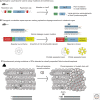Stem Cell DNA Damage and Genome Mutation in the Context of Aging and Cancer Initiation
- PMID: 31932318
- PMCID: PMC7528851
- DOI: 10.1101/cshperspect.a036210
Stem Cell DNA Damage and Genome Mutation in the Context of Aging and Cancer Initiation
Abstract
Adult stem cells fuel tissue homeostasis and regeneration through their unique ability to self-renew and differentiate into specialized cells. Thus, their DNA provides instructions that impact the tissue as a whole. Since DNA is not an inert molecule, but rather dynamic, interacting with a myriad of chemical and physical factors, it encounters damage from both endogenous and exogenous sources. Damage to DNA introduces deviations from its normal intact structure and, if left unrepaired, may result in a genetic mutation. In turn, mutant genomes of stem and progenitor cells are inherited in cells of the lineage, thus eroding the genetic information that maintains homeostasis of the somatic cell population. Errors arising in stem and progenitor cells will have a substantially larger impact on the tissue in which they reside than errors occurring in postmitotic differentiated cells. Therefore, maintaining the integrity of genomic DNA within our stem cells is essential to protect the instructions necessary for rebuilding healthy tissues during homeostatic renewal. In this review, we will first discuss DNA damage arising in stem cells and cell- and tissue-intrinsic mechanisms that protect against harmful effects of this damage. Secondly, we will examine how erroneous DNA repair and persistent DNA damage in stem and progenitor cells impact stem cells and tissues in the context of cancer initiation and aging. Finally, we will discuss the use of invertebrate and vertebrate model systems to address unanswered questions on the role that DNA damage and mutation may play in aging and precancerous conditions.
Copyright © 2020 Cold Spring Harbor Laboratory Press; all rights reserved.
Figures




Similar articles
-
Aging-Induced Stem Cell Mutations as Drivers for Disease and Cancer.Cell Stem Cell. 2015 Jun 4;16(6):601-12. doi: 10.1016/j.stem.2015.05.002. Cell Stem Cell. 2015. PMID: 26046760 Free PMC article. Review.
-
Genome instability, cancer and aging.Biochim Biophys Acta. 2009 Oct;1790(10):963-9. doi: 10.1016/j.bbagen.2009.03.020. Epub 2009 Mar 31. Biochim Biophys Acta. 2009. PMID: 19344750 Free PMC article. Review.
-
DNA damage response in adult stem cells.Blood Cells Mol Dis. 2014 Apr;52(4):147-51. doi: 10.1016/j.bcmd.2013.12.005. Epub 2014 Jan 28. Blood Cells Mol Dis. 2014. PMID: 24484934 Review.
-
Balancing self-renewal against genome preservation in stem cells: How do they manage to have the cake and eat it too?Cell Mol Life Sci. 2016 May;73(9):1803-23. doi: 10.1007/s00018-016-2152-y. Epub 2016 Feb 17. Cell Mol Life Sci. 2016. PMID: 26886024 Free PMC article. Review.
-
Aging genomes: a necessary evil in the logic of life.Bioessays. 2014 Mar;36(3):282-92. doi: 10.1002/bies.201300127. Epub 2014 Jan 25. Bioessays. 2014. PMID: 24464418 Free PMC article. Review.
Cited by
-
ATR activity controls stem cell quiescence via the cyclin F-SCF complex.Proc Natl Acad Sci U S A. 2022 May 3;119(18):e2115638119. doi: 10.1073/pnas.2115638119. Epub 2022 Apr 27. Proc Natl Acad Sci U S A. 2022. PMID: 35476521 Free PMC article.
-
Can precancerous stem cells be risk markers for malignant transformation in the oral mucosa?Cell Mol Biol Lett. 2023 Apr 7;28(1):30. doi: 10.1186/s11658-023-00441-0. Cell Mol Biol Lett. 2023. PMID: 37029348 Free PMC article.
-
Efficacy and safety of universal (TCRKO) ARI-0001 CAR-T cells for the treatment of B-cell lymphoma.Front Immunol. 2022 Oct 6;13:1011858. doi: 10.3389/fimmu.2022.1011858. eCollection 2022. Front Immunol. 2022. PMID: 36275777 Free PMC article.
-
Canonical Wnt and TGF-β/BMP signaling enhance melanocyte regeneration but suppress invasiveness, migration, and proliferation of melanoma cells.Front Cell Dev Biol. 2023 Nov 13;11:1297910. doi: 10.3389/fcell.2023.1297910. eCollection 2023. Front Cell Dev Biol. 2023. PMID: 38020918 Free PMC article.
-
Aging and Cancer: The Waning of Community Bonds.Cells. 2021 Aug 31;10(9):2269. doi: 10.3390/cells10092269. Cells. 2021. PMID: 34571918 Free PMC article. Review.
References
Publication types
MeSH terms
LinkOut - more resources
Full Text Sources
Other Literature Sources
Medical
